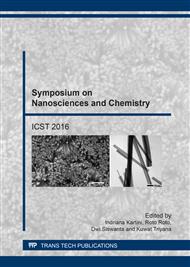p.20
p.26
p.32
p.37
p.44
p.50
p.55
p.65
p.69
Post-Treatments to Enhance Vertical Alignment of ZnO Nanorods on Glass Substrates by Hydrothermal Deposition
Abstract:
Vertically aligned nanorods ZnO have been deposited hydrothermally on the pre-coated ZnO seeded-glass substrates. Enhanced vertical alignment is achieved as a result of combined film post-treatments. Dipped-drawn and immersed-washing the as-synthesized ZnO films in water as well as quenching of the hydrothermal were proposed to hinder excessive deposition and engineer the growth of ZnO nanorods. The XRD patterns shows suppressed growth of ZnO crystallite along (101) with increased textural coefficients on (002), TC002, from 3.94 to 5.23. Dense vertically aligned bundles of ZnO nanorods may reach up to 0.75 μm length. Bandgap energy of the resulted ZnO nanorod thin films were ranging from 3.69 to 3.79 eV, wider than those of bulk ZnO. Hydrothermal technique with simple post-treatments of immersed-washing and hydrothermal quenching has offered robust and efficient method to prepare vertically-aligned 1-D ZnO nanorods potential as photoanodes for dye-sensitized solar cells.
Info:
Periodical:
Pages:
44-49
Citation:
Online since:
July 2017
Keywords:
Price:
Сopyright:
© 2017 Trans Tech Publications Ltd. All Rights Reserved
Share:
Citation:


